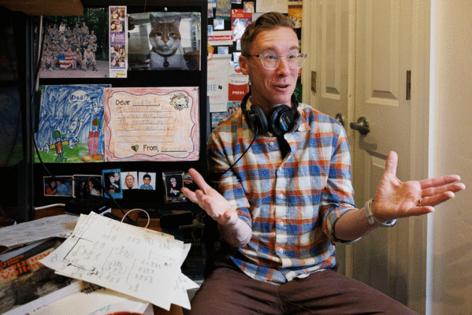A DNA test revealed Matt Katz was conceived by a sperm donor. His mother had no idea
Published in Parenting News
PHILADELPHIA -- Matt Katz wanted to know where his Jewish ancestors once lived in Eastern Europe, so in 2016 he spit into a plastic vial and mailed in his DNA test. He expected to be 100% Ashkenazi Jewish.
Instead, he learned that half his DNA came from Ireland. He was shocked, but perhaps more jarring, so was his mother. She confirmed through her own test that she was indeed his biological mother and also 100% Ashkenazi Jewish.
The mystery transferred to his father.
Katz, now 45, already had a complicated relationship with fathers. The man he knew as his birth father largely disappeared from his life when he was 8 and his mother remarried a man named Richard Katz. As a child, Matt legally changed his last name to match. Richard legally adopted him; he was the one Matt called Dad, the one who played catch with him and taught him to ride a bike.
Now a DNA test suggested that Katz’s long-estranged father wasn’t even related to him. So who was his biological father? And how did his mother not know?
“My identity is all scrambled,” Katz said recently.
Katz’s surprise DNA results launched a five-year investigation into who his father was and the ethically vexed history of donor insemination, a twisting, satisfying story he tells in a new eight-part podcast called Inconceivable Truth. (His Google Doc for the project was titled “Daddy Issues.”) Katz, a longtime Inquirer reporter and now a radio journalist at WNYC, recorded most of it from his and his wife’s bedroom closet in Graduate Hospital, speaking into a microphone amidst the soundproofing presence of folded sweaters.
In this age of direct-to-consumer DNA tests, many, many people have discovered startling truths about how their families were made. Recent studies put the rates of so-called misattributed paternity — the situation Katz found himself in — between 1% and 4% of all births, according to an analysis by the New Yorker. Darker secrets have come out, too. Psychiatrists used to think that incest occurred among one in a million people. DNA testing now suggests the real number of people born to parents who are first-degree relatives (a brother and a sister; a parent and a child) may be closer to one in 7,000, according to unpublished research by British geneticist Jim Wilson recently reported in the Atlantic.
We live in what is perhaps a singular era for these genetic revelations: Older generations never imagined the kind of DNA technology that has developed, and younger generations will always operate with it in mind. The trend now is greater transparency and more access to information, spurred in part by donor-conceived activists.
But in this moment, there are still secrets to uncover and new family trees to create.
...continued
©2024 The Philadelphia Inquirer, LLC. Visit at inquirer.com. Distributed by Tribune Content Agency, LLC.







Comments